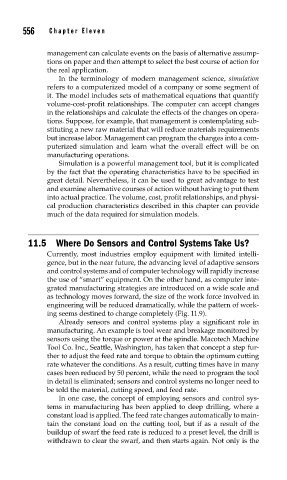Page 603 - Sensors and Control Systems in Manufacturing
P. 603
556
Ele v e n
Cha p te r
management can calculate events on the basis of alternative assump-
tions on paper and then attempt to select the best course of action for
the real application.
In the terminology of modern management science, simulation
refers to a computerized model of a company or some segment of
it. The model includes sets of mathematical equations that quantify
volume-cost-profit relationships. The computer can accept changes
in the relationships and calculate the effects of the changes on opera-
tions. Suppose, for example, that management is contemplating sub-
stituting a new raw material that will reduce materials requirements
but increase labor. Management can program the changes into a com-
puterized simulation and learn what the overall effect will be on
manufacturing operations.
Simulation is a powerful management tool, but it is complicated
by the fact that the operating characteristics have to be specified in
great detail. Nevertheless, it can be used to great advantage to test
and examine alternative courses of action without having to put them
into actual practice. The volume, cost, profit relationships, and physi-
cal production characteristics described in this chapter can provide
much of the data required for simulation models.
11.5 Where Do Sensors and Control Systems Take Us?
Currently, most industries employ equipment with limited intelli-
gence, but in the near future, the advancing level of adaptive sensors
and control systems and of computer technology will rapidly increase
the use of “smart” equipment. On the other hand, as computer inte-
grated manufacturing strategies are introduced on a wide scale and
as technology moves forward, the size of the work force involved in
engineering will be reduced dramatically, while the pattern of work-
ing seems destined to change completely (Fig. 11.9).
Already sensors and control systems play a significant role in
manufacturing. An example is tool wear and breakage monitored by
sensors using the torque or power at the spindle. Macotech Machine
Tool Co. Inc., Seattle, Washington, has taken that concept a step fur-
ther to adjust the feed rate and torque to obtain the optimum cutting
rate whatever the conditions. As a result, cutting times have in many
cases been reduced by 50 percent, while the need to program the tool
in detail is eliminated; sensors and control systems no longer need to
be told the material, cutting speed, and feed rate.
In one case, the concept of employing sensors and control sys-
tems in manufacturing has been applied to deep drilling, where a
constant load is applied. The feed rate changes automatically to main-
tain the constant load on the cutting tool, but if as a result of the
buildup of swarf the feed rate is reduced to a preset level, the drill is
withdrawn to clear the swarf, and then starts again. Not only is the

